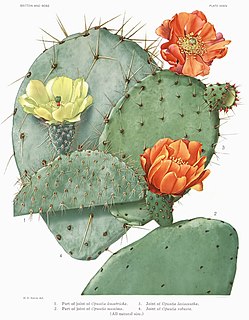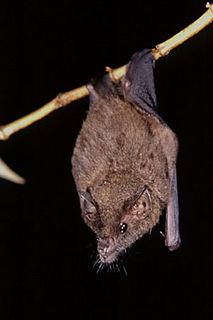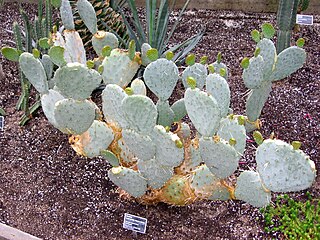
A cactus is a member of the plant family Cactaceae, a family comprising about 127 genera with some 1750 known species of the order Caryophyllales. The word "cactus" derives, through Latin, from the Ancient Greek κάκτος, kaktos, a name originally used by Theophrastus for a spiny plant whose identity is not certain. Cacti occur in a wide range of shapes and sizes. Most cacti live in habitats subject to at least some drought. Many live in extremely dry environments, even being found in the Atacama Desert, one of the driest places on earth. Cacti show many adaptations to conserve water. Almost all cacti are succulents, meaning they have thickened, fleshy parts adapted to store water. Unlike many other succulents, the stem is the only part of most cacti where this vital process takes place. Most species of cacti have lost true leaves, retaining only spines, which are highly modified leaves. As well as defending against herbivores, spines help prevent water loss by reducing air flow close to the cactus and providing some shade. In the absence of leaves, enlarged stems carry out photosynthesis. Cacti are native to the Americas, ranging from Patagonia in the south to parts of western Canada in the north—except for Rhipsalis baccifera, which also grows in Africa and Sri Lanka.

Opuntia ficus-indica is a species of cactus that has long been a domesticated crop plant grown in agricultural economies throughout arid and semiarid parts of the world. Likely having originated in Mexico, O. ficus-indica is the most widespread and most commercially important cactus. Common English names for the plant and its fruit are Indian fig opuntia, Barbary fig, cactus pear, and spineless cactus, among many. In Mexican Spanish, the plant is called nopal, while the fruit is called tuna, names that may be used in American English as culinary terms.

Cylindropuntia is a genus of cacti, containing species commonly known as chollas, native to northern Mexico and the Southwestern United States. They are known for their barbed spines that tenaciously attach to skin, fur, and clothing.

Brasiliopuntia is a genus in the cactus family, Cactaceae. It contains only one species, Brasiliopuntia brasiliensis.

Cactoblastis cactorum, the cactus moth, South American cactus moth or nopal moth, is native to Argentina, Paraguay, Uruguay and southern Brazil. It is one of five species in the genus Cactoblastis that inhabit South America, where many parasitoids and pathogens control the expansion of the moths' population. This species has been introduced into many areas outside its natural range, including Australia, the Caribbean, and South Africa. In some locations, it has spread uncontrollably and was consequently classified an invasive species. However, in other places such as Australia, it has gained favor for its role in the biological control of cacti from the genus Opuntia, such as prickly pear.

Opuntia engelmannii is a prickly pear common across the south-central and Southwestern United States and northern Mexico. It goes by a variety of common names, including cow's tongue cactus, cow tongue prickly pear, desert prickly pear, discus prickly pear, Engelmann's prickly pear, and Texas prickly pear in the US, and nopal, abrojo, joconostle, and vela de coyote in Mexico.

Glossophaginae is a subfamily of leaf-nosed bats.
Prickly pear may refer to:

Prickly pears include a number of plant species that were introduced and have become invasive in Australia.

Devil's Gap Battery is a coastal battery in the British Overseas Territory of Gibraltar, overlooking the Bay of Gibraltar near the westernmost limits of the Upper Rock Nature Reserve.

Devil's Tongue Battery was an artillery battery in the British Overseas Territory of Gibraltar. The battery could overlook the harbour but the remains are now surrounded by reclaimed land.

Dactylopius is a genus of insect in the superfamily Coccoidea, the scale insects. It is the only genus in the family Dactylopiidae. These insects are known commonly as cochineals, a name that also specifically refers to the best-known species, the cochineal. The cochineal is an insect of economic and historical importance as a main source of the red dye carmine. It has reportedly been used for this purpose in the Americas since the 10th century. Genus Dactylopius is also important because several species have been used as agents of biological pest control, and because several are known as invasive species.

Opuntia macrorhiza is a common and widespread species of cactus with the common names plains prickly pear or twistspine pricklypear or Western pricklypear. It is found throughout the Great Plains of the United States, from Texas to Minnesota, as well as in the desert and Rocky Mountain states from Arizona to Idaho, with sporadic populations in the Mississippi and Ohio Valleys. It is also reported from northern Mexico, in the states of Chihuahua, Sonora, Coahuila, Nuevo León, Durango, Tamaulipas, and San Luís Potosí. The species is cultivated as an ornamental in other locations.
Polyzoa is a genus of ascidian tunicates in the family Styelidae. In old literature Polyzoa was used as the name of the phylum Bryozoa.

Opuntia anahuacensis is a cactus species in the Opuntia genus and a member of the Opuntioideae. It grows along the Gulf Coast of Texas, and perhaps northern Mexico. The plants are short, perhaps 1- or 2-ft tall, but they are wide. Some thickets may be 20- to 40-ft across and composed of multiple plants. The fruit is purplish. The cladodes are uniquely shaped, obovate with a neck. The original description claimed the plants were yellowish green, but they may be green or rarely blue-green.

Opuntia alta is a cactus species in the Opuntia genus. It is a large plant, with some older specimens forming trees to 4.6 metres (15 ft) tall.















